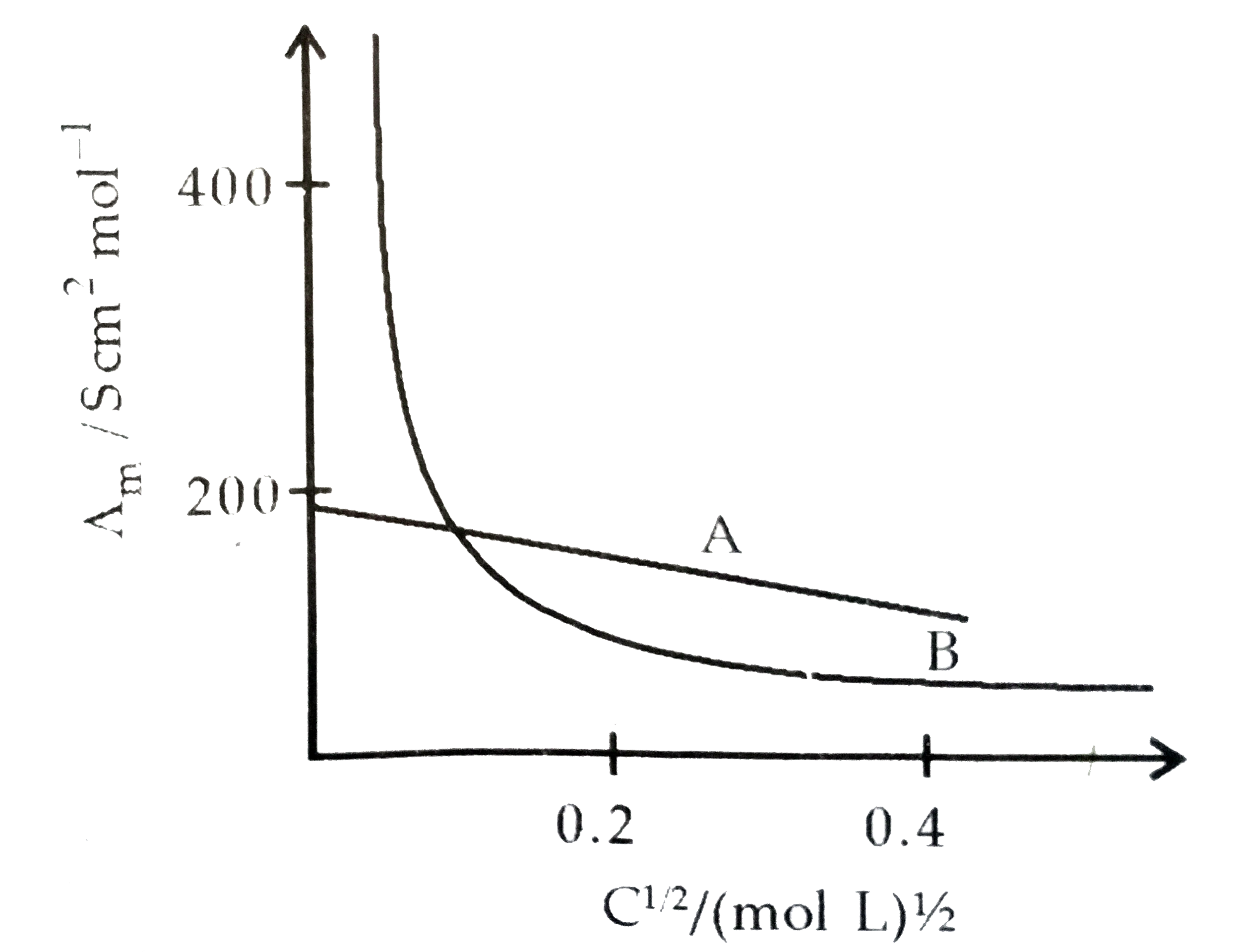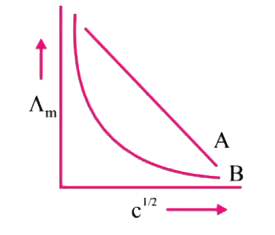The curves obtained when molar conductivity λm (along Y-axis) is plotted against the square root of concentration C1/2 (along X-axis) for two electrolytes 'A' and 'B' are shown.

(a) What can you say about the nature of the two electrolytes ?
(b) How do you account for the increase in molar conductivity Λm for the electrolytes A and B on dilution ?

(a) Electrolyte 'A' is a strong while 'B' is a weak electrolyte.
(b) In case of strong electrolyte, 'A', the ionisation is already complete. With dilution, the interionic forces decrease. Therefore, the ionic mobility increases leading to small increase in the value of Λm. This continues till limiting value of molar conductance reaches. It is denoted either as Λ0 or as Λ∞. In case of weak electrolyte, 'B' the extent of dissociation is very small. It increase with dilution. As a result, the value of Λm increases with dilution. Since there is an enormous increase in ionisation upon dilution, there is large increase in the value of Λm when the solution is very dilute. This has been depicted in the curve. In case of electrolyte 'B', the limiting value of the molar conductance (Λ0m) cannot be achieved since the dissociation of the electrolyte is never complete.
Topper's Solved these Questions
- ELECTROCHEMISTRYBook:DINESH PUBLICATIONChapter:ELECTROCHEMISTRYExercise:PROBLEMS FOR PRACTIVE
Explore 56 Videos
- ELECTROCHEMISTRYBook:DINESH PUBLICATIONChapter:ELECTROCHEMISTRYExercise:ADDITIONAL NUMERICAL PROBLEMS FOR PRACTICE
Explore 12 Videos
- ELECTROCHEMISTRYBook:DINESH PUBLICATIONChapter:ELECTROCHEMISTRYExercise:QUESTIONS FROM BOARD EXAMINATIONS
Explore 81 Videos
- D-AND -F BLOCK ELEMENTSBook:DINESH PUBLICATIONChapter:D-AND -F BLOCK ELEMENTSExercise:BRAIN STORMING MULTIPLE CHOICE QUESTIONS (MCQS)
Explore 13 Videos
- ETHERSBook:DINESH PUBLICATIONChapter:ETHERSExercise:(MCQs)
Explore 8 Videos
Similar Questions
The following curve is obtained when molar conductivity Λm is plotted against the square root of concentration C1/2 (x-axis) for two electrolytes A and B :
(a) What can you say about the nature of the two electrolytes A and B ?
(b) How do you account for the increase in molar conductivity A, for the electrolytes A and B on dilution ?
View SolutionThe following curve is obtained when molar conductivity (∧m) is plotted against the square root of concentration, c1/2 for two electrolytes A and B
(a) How do you account for the increase in the molar conductivity of the electrolyte A on dilution.

(b) As seen from the graph, the value of limiting molar conductivity (∧0m) for electrolyte B cannot be obtained graphically. How can this value be obtained?1
View Solution
Knowledge Check
According to Kohlrausch law, the limiting molar conductivity of an electrolyte, AmBn, can be expressed as
AΛ0m=m+λ0An+−nλ_(Bm−)0BΛ0m=m+λ0Am++nλ_(Bn−)0CΛ0m=n+λ0Am+−mλ_(Bn−)0DΛ0m=m+λ0An+−nλ_(Bm−)0
The following curve is obtained when molar conductivity (∧m) is plotted against the square root of concentration, c1/2 for two electrolytes A and B
(a) How do you account for the increase in the molar conductivity of the electrolyte A on dilution.

(b) As seen from the graph, the value of limiting molar conductivity (∧0m) for electrolyte B cannot be obtained graphically. How can this value be obtained?1
View SolutionIn the plot of molar conductivity (^ m) vs square root of concentration (c1/2) following curves are obtained for two electrolytes A and B :

Answer the following: (i) Predict the nature of electrolytes A and B.
(ii) What happens on extrapolation of ^ m to concentration approaching zero for electrolytes A and B?
View Solution(a) A steady current of 2 amperes was passed through two electrolytic cells X and Y connected in series containing electrolytes FeSO4 and ZnSO4 until 2.8 g of Fe deposited at the cathode of cell X. How long did the current flow ? Calculate the mass of Zn deposited at the cathode of cell Y
(Molar mass : Fe= 56 g mol−1 Zn-65.3g mol−1, 1F -96500 C mol−1)
(b) In the plot of molar conductivity (∧m) vs Square root of concentration (c1/2), following curves are obtained for two electrolytes.
A and B:
Answer the following : (i) Predict the nature of electrolytes A and B. (ii) What happens on extrapolation of ∧m to concentration approaching zero for electrolytes A and B ?

View Solution(a) A steady current of 2 amperes was passed through two electrolytic cells X and Y connected in series containing electrolytes FeSO4 and ZnSO4 until 2.8 g of Fe deposited at the cathode of cell X. How long did the current flow ? Calculate the mass of Zn deposited at the cathode of cell Y
(Molar mass : Fe= 56 g mol−1 Zn-65.3g mol−1, 1F -96500 C mol−1)
(b) In the plot of molar conductivity (∧m) vs Square root of concentration (c1/2), following curves are obtained for two electrolytes.
A and B:
Answer the following : (i) Predict the nature of electrolytes A and B. (ii) What happens on extrapolation of ∧m to concentration approaching zero for electrolytes A and B ?

View SolutionSolutions of two electrolytes 'A' and 'B' are diluted. It is found that Λm value of 'B' increases 2 times while that of 'A' increases20 times. Which of the two is a strong electrolyte ?
View SolutionFor electrolyte AxBy which is /are not correct relation between molar conductivity (∧M) and equivalent conductivity (∧eq)
View SolutionFor electrolyte AxBy which is /are not correct relation between molar conductivity (∧M) and equivalent conductivity (∧eq)
View Solution

